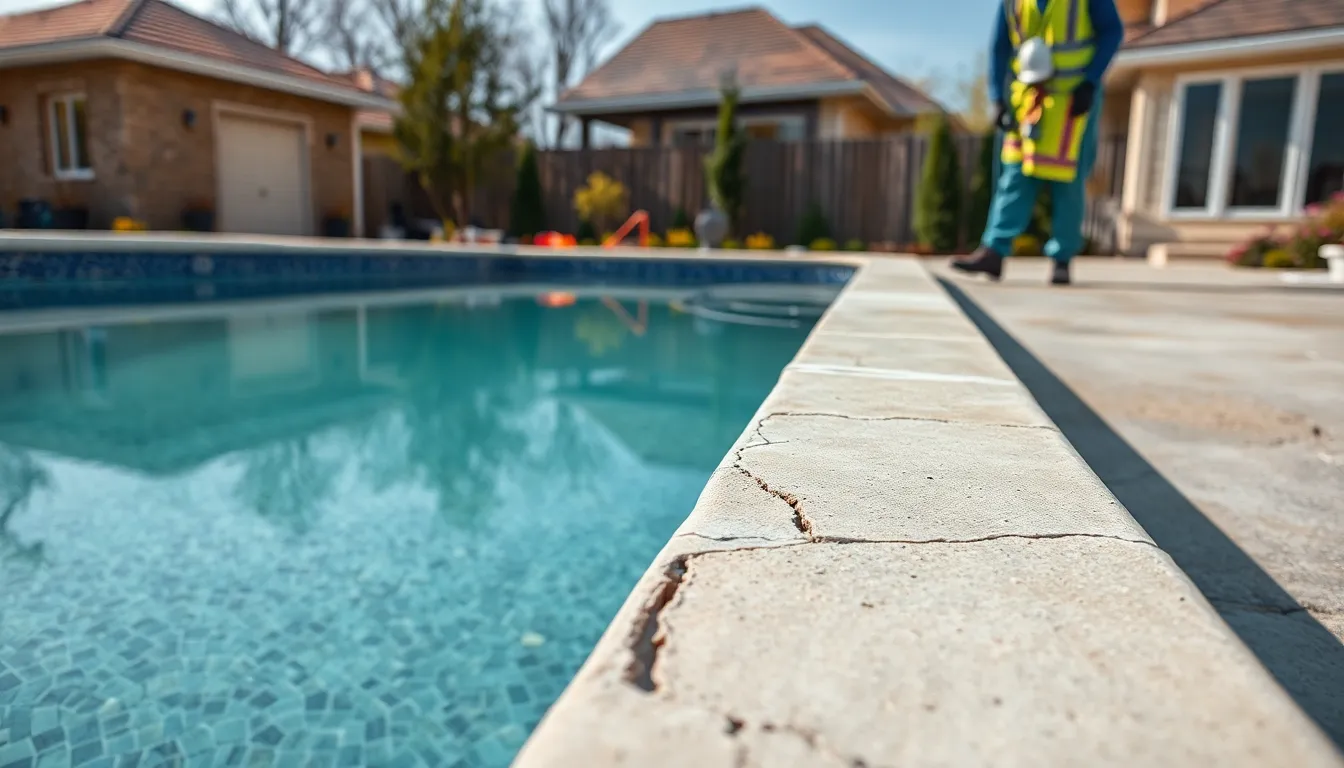A concrete pool can be a backyard oasis, but when cracks and leaks start to appear, it can quickly turn into a watery disaster zone. Nobody wants to dive into a pool that resembles a scene from a horror movie. With the right concrete pool repair, not only can those unsightly blemishes vanish, but the summer fun can continue without a hitch.
Table of Contents
ToggleOverview Of Concrete Pool Repair
Concrete pool repair addresses issues like cracks, leaks, and surface deterioration. Regular inspection plays a critical role in identifying problems early. A visible crack might indicate structural damage, while a leak can lead to water loss and increased utility bills.
Repair options vary depending on the severity of the damage. Minor cracks typically require simple filling with epoxy or specialized sealants. Larger cracks need thorough assessments and possibly resurfacing to restore the pool’s integrity.
Traditionally, professionals suggest applying hydraulic cement for leaks, providing a quick solution that resists water. Surface scaling, caused by poor maintenance or chemical imbalances, often necessitates resurfacing. This process re-establishes a smooth finish, enhancing aesthetics and usability.
Before initiating repairs, understanding the pool’s design and the material’s properties is vital. Safety must always come first—using protective gear is essential during restoration work.
Furthermore, the conditions of the weather impact repair effectiveness. Warm, dry days favor quicker drying times for materials. In contrast, cold or damp weather can hinder repair applications, prolonging the process and potentially affecting quality.
Investing in preventative maintenance also plays a significant role in minimizing future repairs. Regular cleaning, proper water chemistry management, and prompt attention to small issues can extend the life of a concrete pool. Not only does this increase longevity, but it also enhances enjoyment and safety for swimmers.
Common Issues With Concrete Pools

Concrete pools face several common issues that require attention. Addressing these problems early can prevent more extensive damage later.
Cracks And Chips
Cracks and chips commonly occur due to temperature changes or shifting soil. Small cracks might appear harmless but can grow and compromise pool integrity. Repairing minor cracks involves using a compatible filler to restore the surface. More significant cracks often necessitate a thorough assessment to determine the cause and appropriate repair method. Chips can arise from equipment impact or rough handling of pool toys. Refinishing can address these blemishes, ensuring both aesthetics and safety remain intact.
Surface Pitting And Scaling
Surface pitting and scaling frequently result from poor chemical balance or inadequate maintenance. Acidic water can erode the concrete, leading to a pitted appearance. Scaling forms when mineral deposits accumulate, creating rough patches that impact swim comfort. To repair, it’s essential to balance water chemistry, followed by resurfacing to restore a smooth finish. Regular cleaning and monitoring of chemicals prevent these issues, maintaining the long-term condition of the pool.
Repair Techniques
Concrete pool repairs employ specific techniques to address issues effectively. Understanding each method enhances long-term pool performance.
Epoxy Injection
Epoxy injection serves as a common technique for repairing cracks. This method involves the use of a two-part epoxy resin that bonds to concrete, creating a strong seal. It effectively fills gaps and prevents leaks while offering resilience against water pressure. Professionals apply the epoxy through small ports at regular intervals along the crack. The injection process ensures complete penetration, reinforcing the structural integrity of the pool. Once cured, the epoxy becomes waterproof, reducing the risk of further damage. Regular monitoring of repaired areas ensures the effectiveness of the solution.
Resurfacing
Resurfacing provides a solution for deteriorated surfaces. This technique layers new concrete over the existing surface, effectively restoring appearance and functionality. Areas suffering from scaling, pitting, or wear benefit from this approach. Application involves cleaning the surface thoroughly before adding a mix designed for durability and aesthetics. Professionals often recommend resurfacing every 5 to 10 years to maintain pool quality. While it offers aesthetic improvements, resurfacing also protects against future damage caused by corrosion or chemical imbalances. Maintaining balanced water chemistry helps extend the lifespan of the resurfaced area.
Maintenance Tips For Concrete Pools
Maintaining a concrete pool requires diligence and attention. Regular upkeep prevents costly repairs and enhances safety.
Regular Inspections
Regular inspections serve as the foundation for effective maintenance. Inspecting the pool twice a year allows early identification of issues. Look for cracks, chips, and surface damage during these checks. Addressing minor problems immediately prevents them from escalating. Equipment and surrounding areas deserve attention too; they can contribute to structural integrity. Safety concerns may arise from unaddressed issues, so it’s crucial to act swiftly. Scheduling inspections before and after the swimming season ensures a well-maintained pool.
Proper Chemical Balancing
Proper chemical balancing plays a vital role in concrete pool maintenance. Maintaining pH levels between 7.2 and 7.8 helps protect the surface from erosion. Regularly testing chlorine, alkalinity, and calcium hardness keeps water chemistry in check. Imbalances can lead to scaling or etching on concrete surfaces. Adjustments should occur based on test results; never overlook the importance of maintaining ideal conditions. Frequent water testing every week or two during the swim season supports a healthy pool environment. Turn to professional services if difficulties arise with water balance, ensuring effective resolution.
Addressing concrete pool repairs promptly can save homeowners from larger issues down the line. By staying vigilant and conducting regular inspections, they can catch cracks and leaks early, preserving the pool’s integrity and appearance. Utilizing the right repair techniques ensures that the pool remains a safe and enjoyable space for family and friends.
Preventative maintenance plays a crucial role in extending the life of a concrete pool. By managing water chemistry and performing routine cleanings, homeowners can minimize the risk of damage. Ultimately, investing in proper care not only enhances the pool’s functionality but also contributes to a more enjoyable backyard experience.



